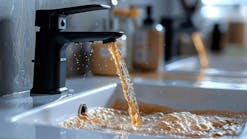The Réserve faunique des Laurentides wildlife reserve in Quebec, Canada, covers more than 3,000 sq miles, encompasses more than 2,000 lakes and rivers, and welcomes outdoor enthusiasts year round. Several small drinking water systems throughout the park provide potable water for park guests. Though the water source for each system is unique, each uses disinfection with ultraviolet (UV) light to achieve the required log reduction credits for Giardia, Cryptosporidium and viruses to meet regional regulations. However, traditional UV systems have been troubled with issues like quartz sleeve fouling and low UV transmission (UVT). The solution has been to upgrade to newer UV system technologies that incorporate a flowmeter and lamp-dimming capability.
Groundwater Challenges
Site 1 is a plant treating well water contaminated with iron and manganese. Two UV systems were placed in series to achieve the required 4-log reduction credit for viruses. For minerals, a cation exchange system was placed upstream of the UV system, but residual minerals deposited on the quartz sleeves, sending the systems into alarm.
Site 2 treats groundwater under the influence of surface water. For this installation, two UV systems in series achieved log reduction credits for Giardia (3-log), Cryptosporidium (2-log) and viruses (4-log). Frequent alarming of the UV systems was traced to hardness minerals (Ca2+ and Mg2+) in the well water fouling the quartz sleeve.
Quartz sleeve fouling results from the accumulation of minerals like calcium, magnesium and iron on the sleeve-water interface. Fouling can rapidly and significantly decrease the UV dose the water receives, resulting in reduced disinfection performance. This effect is exacerbated in applications where there are extended periods of no flow, which is common for small public water systems. In the wildlife reserve, for instance, the water demand might be steady throughout the day but relatively low at night, or busy on the weekends and quiet on weekdays. Regardless of demand, as the water sits in the UV chamber, it heats up and the mineral buildup worsens. The net effect was that the UV systems required more maintenance and downtime to clean the sleeves, which was driving up costs for park management.
The solution was to upgrade to new technology. UV systems equipped with lamp-dimming technology are a new solution to quartz sleeve fouling that avoids temperature rise during no-flow conditions. This is achieved by adding functionality to the controller that reduces the UV lamp power, or “dims” the lamp, during periods of no flow.
Adjusting lamp power during periods of no flow keeps the water temperature low and reduces sleeve fouling. This function is enabled by a built-in flowmeter. Lamp dimming is automatically triggered when no flow is detected for one minute. The power is reduced by as much as half after another minute. When the flowmeter once again detects water demand, the UV lamp immediately returns to full power. This happens with no interruption in disinfection, resolves sleeve fouling, allows for extension of routine maintenance schedules, and lowers power consumption, leading to cost savings.
At Site 1, a series of two UV systems achieved a 4-log reduction credit for viruses.
Surface Water Challenges
Site 3 differs in that its source water is from a lake and there is a small distribution network that requires a residual disinfectant connected to the treatment plant. Using both UV and chlorination achieved the necessary log reduction credits while minimizing the use of chlorine.
The water source introduced a common surface water challenge: tannins, which are organic matter typically imparted by decaying vegetation. Their presence is signaled by a yellow tinge, tart taste and/or earthy odor. Tannins are not a health issue; however, they are aesthetically displeasing. They affect UV disinfection because they absorb UV light as it shines through water, causing UVT to drop as low as 50%. As a result, the UV light dose reaching microbes in the water is reduced and disinfection is incomplete.
The Site 3 plant used granular activated carbon filters to remove tannins, but they had limited absorption capacity and were not always fully effective. As a result, any drop in UVT would put the system into alarm.
UV dose is the mathematical product of UV intensity and exposure time, which is controlled by flow rate through the chamber. In traditional UV systems, flow is assumed to be constantly at the maximum, so low-UVT alarms are triggered by even slight reductions in UVT. These often are referred to as nuisance alarms, because although a reduction in UVT reduces UV dose, the degree to which it does so depends on the actual flow rate. Upgrading to a UV system that calculates real-time dose based on flow and UV light intensity was the solution. Now, as long as slight variances in UVT do not occur at or near peak flows, there will be no more alarms.
Three different sites, one solution: Leveraging newer UV technology, specifically lamp dimming and flow measurement, can ease maintenance and troubleshooting efforts while enabling energy savings for facilities.



